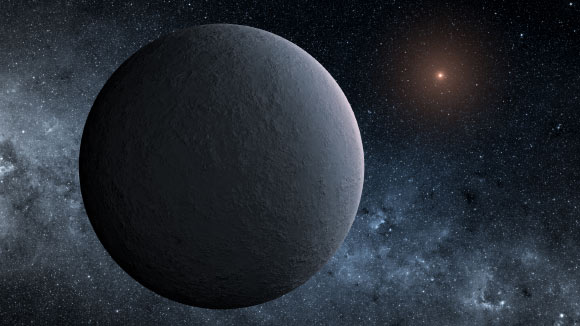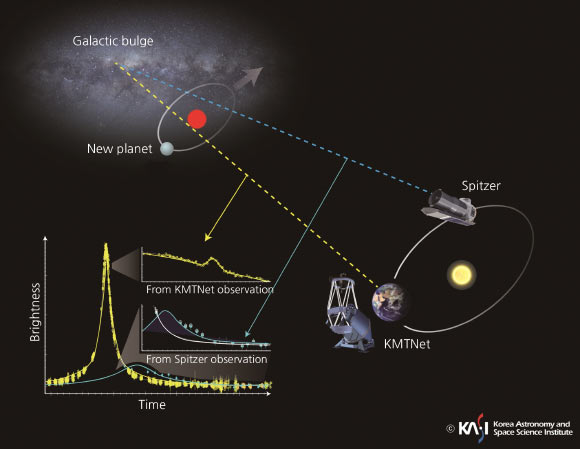Using a planet-hunting technique called gravitational microlensing, astronomers have detected an Earth-mass planet orbiting an ultracool dwarf 12,750 light-years away.

This artist’s concept shows the Earth-mass exoplanet OGLE-2016-BLG-1195Lb. Image credit: NASA / JPL-Caltech.
By combining data from space- and ground-based telescopes, the astronomers determined that the newfound world is about 1.4 times the Earth’s mass.
Called OGLE-2016-BLG-1195Lb, the planet orbits an ultracool dwarf at only 1.16 times the Earth-Sun distance.
The host, just 7.8% the mass of our Sun, is either a brown dwarf or a very low-mass star.
According to the team, OGLE-2016-BLG-1195Lb is extremely cold, likely even colder than Pluto is in the Solar System.
“This ‘iceball’ planet is the lowest-mass planet ever found through microlensing,” said Dr. Yossi Shvartzvald, a researcher at NASA’s Jet Propulsion Laboratory, and lead author of a paper published in the Astrophysical Journal Letters (arXiv.org preprint).
Microlensing occurs when a foreground star amplifies the light of a background star that momentarily aligns with it.
If the foreground star has planets, then the planets may also amplify the light of the background star, but for a much shorter period of time than their host star.
The exact timing and amount of light amplification can reveal clues to the nature of the foreground star and its accompanying planets.
The planetary microlensing event OGLE-2016-BLG-1195 was first detected by the Optical Gravitational Lensing Experiment (OGLE).
Dr. Shvartzvald and co-authors then used NASA’s Spitzer Space Telescope and the Korea Microlensing Telescope Network (KMTNet) to track the event and find the planet.

Joint observations of the planetary microlensing event OGLE-2016-BLG-1195 by KMTNet and Spitzer. Image credit: Korea Astronomy and Space Science Institute.
OGLE-2016-BLG-1195Lb is located in the Galactic disk, at 12,750 light-years toward the bulge. It aids astronomers in their quest to figure out the distribution of planets in our Galaxy.
An open question is whether there is a difference in the frequency of planets in the Milky Way’s central bulge compared to its disk.
“Although we only have a handful of planetary systems with well-determined distances that are this far outside the Solar System, the lack of Spitzer detections in the bulge suggests that planets may be less common toward the center of our Galaxy than in the disk,” said co-author Dr. Geoff Bryden, also from NASA’s Jet Propulsion Laboratory.
OGLE-2016-BLG-1195Lb also adds to two previous microlensing discoveries of terrestrial planets (MOA-2007-BLG-192Lb and OGLE-2013-BLG-0341Lb) orbiting ultracool dwarfs.
“These suggest that the protoplanetary disks of ultracool dwarfs have sufficient mass to form terrestrial planets, as also hinted at by direct imaging of such disks,” the astronomers said.
“The location of these planets, at about 1 AU (Earth-Sun distance), support planet formation predictions.”
“However, since the sensitivity of current microlensing surveys for systems with such small mass ratios is very narrow, around projected separations of 1 AU, they cannot set strong constraints on the presence of planets elsewhere around ultracool dwarfs, such as the much closer separations seen in the TRAPPIST-1 system.”
_____
Y. Shvartzvald et al. 2017. An Earth-mass Planet in a 1 AU Orbit around an Ultracool Dwarf. ApJL 840, L3; doi: 10.3847/2041-8213/aa6d09







